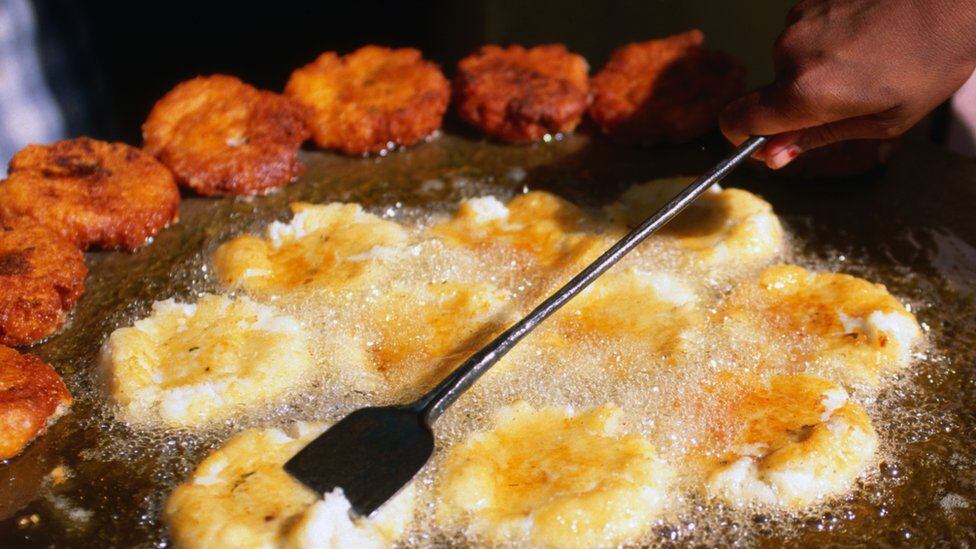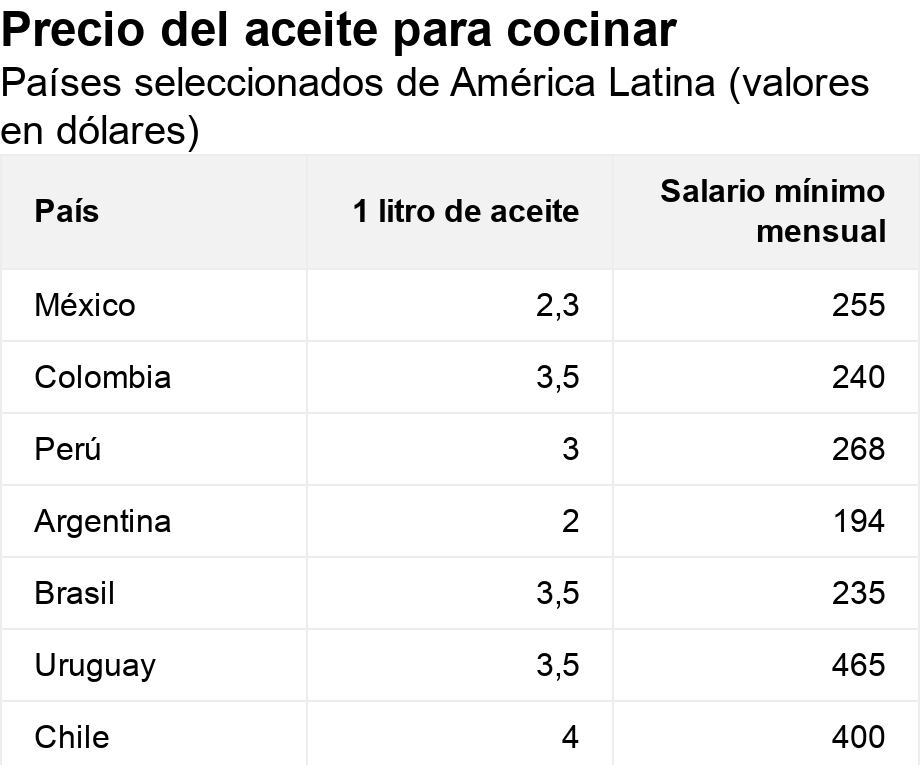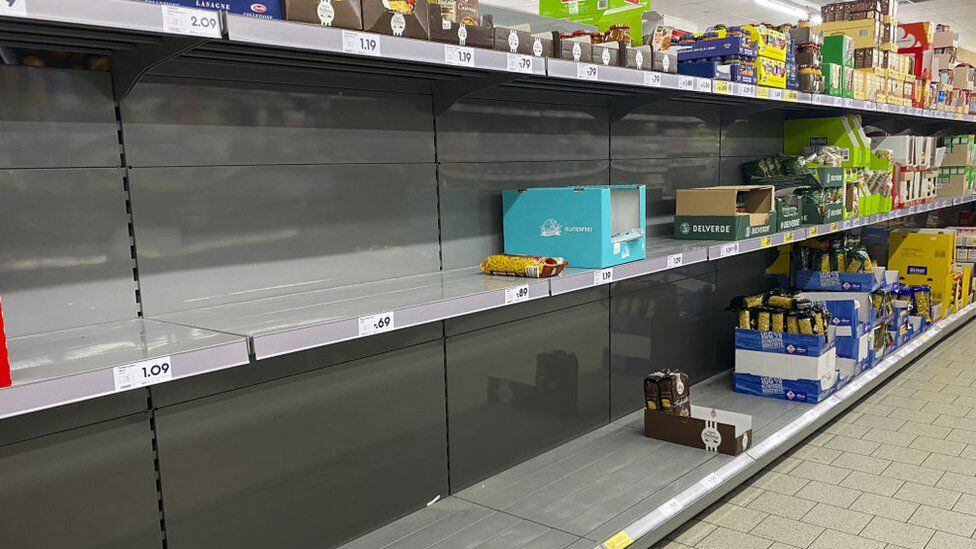Fried eggs? Maybe not… And why don’t we make some fish or chips?
The answer to that question is becoming increasingly difficult as the prices of vegetable oils – and especially sunflower oil – have climbed so high that they have become a luxury in the kitchen.
Look: When someone kills their abusive partner, is it murder? The case that divided two families
So high that some consumers complain and also laugh on social networks with messages like “I am selling a shirt with oil stains.”
In Chile, for example, a bottle of pisco (the most common alcoholic beverage in the country) is cheaper than one of oil in some supermarkets.
And in Mexico it is the product whose price has increased the most within the food basket measured by the National Institute of Statistics (INEGI).
In the United Kingdom, Spain, Italy and Germany, policies of rationingwith some supermarkets putting a purchase limit of between one and three liters per person per day.
Along with rationing, it is increasingly common to find empty shelves.
The problem is not only that the price has gone up, but that in some businesses there simply isn’t.
The “liquid gold”
The escalation in fuel and food prices occurs in the context of rampant inflation affecting the entire world, driven mainly by the war in ukraine and the economic effects left by the covid-19 pandemic.
The value of food in the world has skyrocketed so much that international organizations have warned of an increase in hunger in the poorest countries.

In addition to other food products such as wheat, corn, or soybeans – which have reached unthinkable prices – oil is one of the most affected.
Worldwide, the value of vegetable oils has increased 46.5% in the last 12 monthsaccording to the Food Price Index of the Food and Agriculture Organization of the United Nations (FAO).
In Latin America, oil inflation in the last year covers a very wide range that goes from 9% in Bolivia to more than 60% in countries like Costa Rica.
The price of what is now called “liquid gold” that is sold in Chilean supermarkets as “vegetable oil” increased 67% between January and April of this year, according to the Office of Agricultural Studies and Policies (ODEPA), while sunflower oil (also known as marigold oil) was up 63.6%.
In this video published on Twitter, customers appear almost desperate to get oil in a supermarket.
Speculation began.#oil #Chile#speculation pic.twitter.com/Rdnnm3fYrP
— Anti-Corruption Agency as the 4th power of the State (@envivoonline) April 8, 2022
In countries such as Colombia and Mexico, the increase is around 40%, while in others such as Guatemala, Panama or Ecuador, the increase has been —on average— greater than 20%.
Ecuadorians have also taken to social networks to express their discomfort over the one-liter bottle at US$6 in some stores.
In the clouds. The price of oil rises uncontrollably. A liter is sold for $6 in supermarkets. pic.twitter.com/yOvoxcCTLW
– LaHistoria (@lahistoriaec) May 9, 2022
These are estimated values that try to reflect an average of the increases in different parts of a country, but, without a doubt, the rise will depend on the neighborhood, the city, the supermarket and the brand of oil.
A look at the price in dollars of a liter of vegetable oil according to the data sent by some BBC Mundo correspondents can help to get an idea of the cost of the product in relation to the minimum wage in some countries.

Sunflower oil and war
Among all the vegetable oils available on the market, the one that is most scarce and, therefore, has risen the most in price, is sunflower oil.
Known as “the granary of Europe”, Ukraine and Russia accounted for 71% of exports of sunflower oil last year, according to the company specializing in analysis of the global oil market ISTA Mielke GmbH, based in Hamburg, Germany.
With the war, supply has dropped to minimum levels, a problem that adds to the declining production of recent years that already had the market in trouble.
“A big concern”
Alejandro Betancourt, an oil expert at ISTA Mielke GmbH, says that the global production of vegetable oils has shrunk in recent years.
The prices of the four main oils – sunflower, palm, rapeseed (canola) and soybeans – “have tripled since 2019″.

This situation has worsened in the last two months, he tells BBC Mundo, due to the war in Ukraine and a sharp decline in palm oil exports, both due to lower production and export restrictions imposed in Indonesia.
“There is great concern about the inflation of food prices and the worsening of the food supply,” he says.
“The Triple Crisis”
And the future does not look very encouraging for now, explains Gustavo Idigoras, president of the Argentine Chamber of the Oil Industry and Cereal Exporters Center.
The oil market “has no prospect of stabilizing. We have to prepare for at least two years of high prices.” from the moment the war ends, he tells BBC Mundo.

The situation is complex because several causes have come together for the current increase in prices, beyond the droughts that have been affecting global production.
On the one hand, the end of the pandemic increased oil consumption and the war in Ukraine reduced supply.
But there is another element at play, he explains, that is fundamental: a high demand for vegetable oils to be used in the biofuel industry.
“It is a triple crisis due to the pandemic, biofuels and war”says Idigoras.

Source: Elcomercio

:quality(75)/cloudfront-us-east-1.images.arcpublishing.com/elcomercio/GE4DCMZNGA2S2MJWKQYDAORRHA.jpg)





